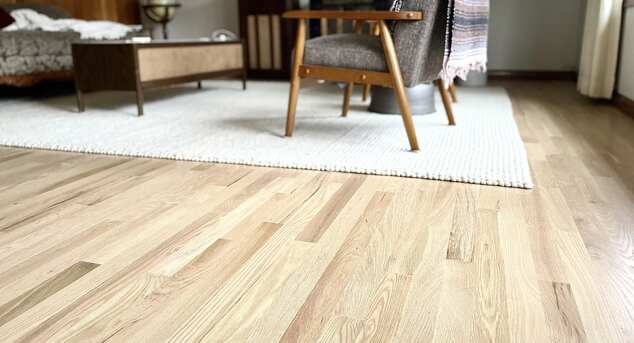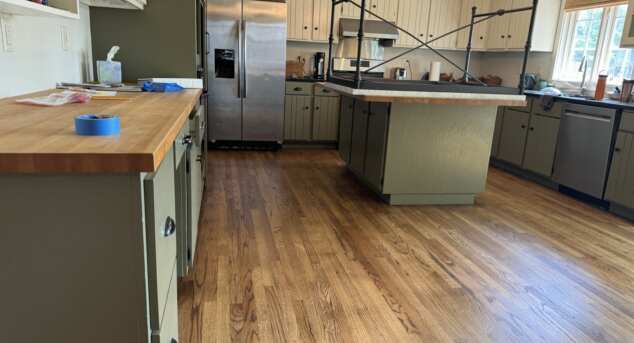Exploring the World of Hardwood Flooring: Types, Brands, Installation, Trends, and Costs
Posted by Aaron Schaalma
Types of Hardwood Flooring
When it comes to enhancing the aesthetic appeal and increasing the value of a home, nothing beats the timeless elegance of hardwood flooring. Used for centuries, hardwood floors offer durability, warmth, and a natural charm that can complement any interior design style. But did you know there are numerous types of hardwood flooring? Let's delve into the different types, their unique characteristics, pros, and cons, and what homeowners, interior designers, and real estate agents have to say about them.
1. Solid Hardwood Flooring
Solid hardwood flooring is made from a single, solid piece of hardwood. It's known for its longevity and can be sanded and refinished multiple times throughout its life, making it a popular choice for homeowners and designers alike. Popular types of solid hardwood include oak, maple, and walnut.
Pros: Highly durable, can be refinished, adds significant value to the property.
Cons: Susceptible to moisture and temperature changes, higher installation cost.
2. Engineered Hardwood Flooring
Engineered hardwood flooring is made of a core of hardwood or plywood with a layer of hardwood veneer affixed to the top surface. It's designed to reduce the moisture problems associated with conventional hardwood. It comes in a wide range of species, including oak, hickory, and maple.
Pros: Resistant to moisture and heat, more stable, can be installed over concrete.
Cons: Cannot be refinished as many times as solid hardwood, varying quality levels.
3. Reclaimed Hardwood Flooring
Reclaimed hardwood flooring is made from wood that's been taken from old buildings and barns. It's a sustainable choice that brings a piece of history and a unique character to homes.
Pros: Eco-friendly, unique aesthetic, story-telling element.
Cons: Limited availability, can be expensive, potential presence of nails or other residues.
4. Parquet Hardwood Flooring
Parquet hardwood flooring is a type of wood flooring made from small blocks or strips of wood which are laid to create a regular and geometric pattern. It's a way to show off the beauty of the wood.
Pros: Stunning visual effect, customizable patterns, adds a high-end look.
Cons: Requires expert installation, can be costly, not suitable for all decor styles.
The Choice That’s Right for You
Choosing the right type of hardwood flooring depends on various factors, including lifestyle, budget, and personal preference. Solid and engineered hardwoods are great for their durability, reclaimed wood offers a unique look and eco-friendly benefits, while parquet flooring adds a touch of luxury. As trends evolve, we're also seeing an increase in the use of exotic wood species and finishes, offering even more options to choose from.
As always, it's recommended to seek professional advice when choosing and installing hardwood floors to ensure you're making the best decision for your specific needs and circumstances.
Hardwood Flooring Materials
When it comes to choosing the perfect flooring for your home, hardwood is a timeless option that never goes out of style. Known for its durability, versatility, and inherent beauty, hardwood flooring materials come in a wide range of types, styles, and finishes, each with its own unique set of characteristics. In this section, we'll delve into the world of hardwood flooring materials, exploring the latest trends, innovations, and key considerations to help homeowners, interior designers, and real estate agents make informed decisions.
Trends in Hardwood Flooring Materials
From wide planks and reclaimed wood to exotic species and sustainable options, the world of hardwood flooring materials is constantly evolving. Here are some of the latest trends making waves in the industry:
Wide Planks: Wide plank flooring, typically measuring 5" or greater in width, is gaining popularity for its ability to open up spaces and create a seamless, contemporary look.
Reclaimed Wood: As sustainability becomes increasingly important, reclaimed wood, which is repurposed from old buildings and structures, is being sought after for its unique character and eco-friendly appeal.
Exotic Species: Homeowners and designers looking to make a statement are turning to exotic species like Brazilian Cherry and Tigerwood for their striking colors and grain patterns.
The Impact of Hardwood Flooring on Home Value
Hardwood flooring is often a key selling point for homes on the market. According to a report from the National Association of Realtors, 54% of home buyers were willing to pay more for a home with hardwood flooring. This demonstrates the significant impact that quality hardwood flooring materials can have on a home's value.
The world of hardwood flooring materials is diverse and dynamic, offering a wealth of options to suit any style, budget, and lifestyle. Whether you're a homeowner looking to invest in your home, an interior designer seeking the latest trends, or a real estate agent aiming to maximize home values, understanding the ins and outs of hardwood flooring materials is key to making the right choice.
Hardwood Flooring Brands
When it comes to choosing wooden flooring for your home, the brand matters. From durability to design, each brand offers its unique take on hardwood flooring. Let's dive into the world of hardwood flooring brands and see what homeowners, interior designers, and real estate agents have to say about them.
Top Hardwood Flooring Brands
Based on industry reviews, expert opinions, and customer testimonials, here are some of the top hardwood flooring brands:
Bruce: Known for their durability and vast selection of colors and styles.
Carlisle: Renowned for their wide plank floors and custom designs.
Mirage: Offers high-quality, sustainable flooring options.
Shaw: Provides a variety of hardwood flooring, from rustic to modern.
Mohawk: Known for their innovative, eco-friendly flooring solutions.
Choosing the right hardwood flooring brand is crucial in achieving the look and quality you want for your home. By considering factors like durability, style, and impact on home value, you can make an informed decision that suits your needs and preferences.
Hardwood Flooring Installation
Hardwood flooring installation is a significant home improvement project that can dramatically enhance the look and value of your property. This section will delve into the specifics of hardwood flooring installation, including the latest trends, tips, and considerations for homeowners, interior designers, and real estate agents. It will provide valuable insights from real-world examples and industry data.
The Basics of Hardwood Flooring Installation
Installing hardwood flooring involves several key steps, including preparing the subfloor, laying down the hardwood planks, and finishing the floor with a protective sealant. The process requires a high level of precision and expertise to ensure the longevity and beauty of the floor.
Hardwood flooring installation is a substantial investment that can enhance the aesthetic appeal and value of a home. However, it requires careful consideration of the pros and cons, as well as an understanding of the latest trends and homeowner preferences. By making informed decisions, homeowners, interior designers, and real estate agents can ensure the successful installation and enjoyment of hardwood floors.
Hardwood Flooring Styles and Trends
Hardwood flooring is a timeless and elegant choice that adds value to any home. As the trends evolve, so do the preferences for hardwood flooring styles. From the type of wood to the finish and installation pattern, there's no shortage of options when it comes to hardwood floors. This section will explore the latest trends in hardwood flooring, providing valuable insights for homeowners, interior designers, and real estate agents.
Current Trends in Hardwood Flooring
The hardwood flooring industry is constantly evolving, with new innovations and styles emerging regularly. Here are some of the most notable trends:
Wide Planks: Wide plank flooring, with boards that are wider than the typical 2 to 3 inches, is gaining popularity. They give rooms a more spacious and modern feel.
Lighter Tones: Lighter shades like blonde and white are trending as they make spaces appear larger and more open.
Matte Finishes: Matte finishes are currently in vogue due to their understated elegance and ability to hide scratches and dust better than glossy finishes.
Environmentally Friendly Options: As more consumers prioritize sustainability, manufacturers are responding with eco-friendly hardwood options, including reclaimed and FSC-certified wood.
Hardwood flooring continues to be a popular choice for homeowners, interior designers, and real estate agents due to its elegance, durability, and positive impact on home value. As trends evolve, so too will the styles and preferences for hardwood floors. Staying informed about these trends can help you make the best decision for your home or project.
Hardwood Flooring Costs
When it comes to home improvement, hardwood flooring continues to be a popular choice among homeowners, interior designers, and real estate agents alike. Not only does it offer a timeless appeal, but it also adds significant value to a home. However, with the vast array of options available in the market, understanding the costs associated with hardwood flooring can be complex. This section aims to unravel the intricacies of hardwood flooring costs.
Hardwood flooring costs can be broken down into three main categories: the cost of the wood itself, installation costs, and maintenance costs. Each of these categories brings its own set of variables that can significantly impact the overall cost of a hardwood flooring project.
Cost of the Wood: The type of wood chosen has a significant impact on the cost. Exotic hardwoods like mahogany or Brazilian cherry are more expensive than domestic woods like oak or maple.
Installation Costs: Installation costs can vary widely depending on the complexity of the project. For instance, installing hardwood flooring on a staircase or around intricate cabinetry can increase labor costs.
Maintenance Costs: While hardwood floors are generally easy to maintain, they do require regular cleaning and occasional refinishing, which can add to the overall cost over time.
Research suggests that the average cost of hardwood flooring ranges from $4 to $12 per square foot for materials alone. Installation can add an additional $3 to $10 per square foot, depending on the complexity of the project. However, these figures can fluctuate based on factors such as geographical location and the specific type of hardwood chosen.
While hardwood flooring costs can be substantial, they are often considered a worthwhile investment. The choice of wood, installation details, and maintenance requirements all play a significant role in determining the overall cost. Therefore, it is essential to consider all these factors when planning a hardwood flooring project.
Conclusion
Hardwood flooring is a valuable investment that significantly enhances the aesthetic appeal and value of a home. With a range of types like solid, engineered, reclaimed, and parquet, each with their unique pros and cons, homeowners can choose based on their lifestyle, budget, and personal preference.
Top hardwood flooring brands, including Bruce, Carlisle, Mirage, Shaw, and Mohawk, offer a variety of styles, durability, and impact on home value. Installation of hardwood flooring requires precision and expertise, and while it can be a substantial investment, it can also boost home resale value significantly.
Current trends in hardwood flooring include wide planks, lighter tones, matte finishes, and environmentally friendly options. The costs associated with hardwood flooring vary based on the type of wood, installation complexity, and maintenance requirements. Despite the significant upfront costs, hardwood flooring is considered a worthwhile investment due to its durability, timeless appeal, and potential to increase home value.
If you’re considering getting hardwood flooring in Wisconsin, please contact us at Signature Custom Flooring to take advantage of our years of experience in designing, installing, maintaining, and repairing beautiful hardwood floors in the midst of Wisconsin’s challenging seasonal environments.


